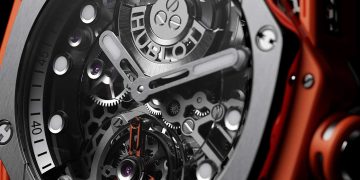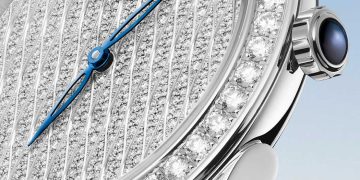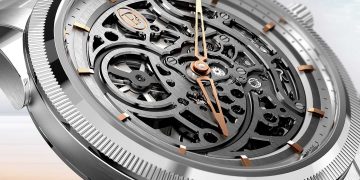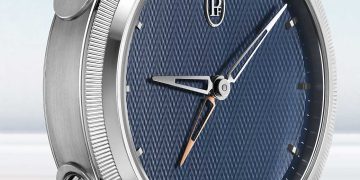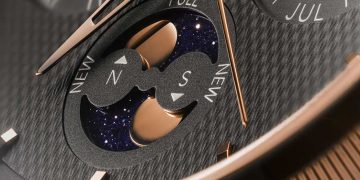Jurassic art
They say that art begets more art; that the act of creativity continues to generate and inspire other creations in turn. This is certainly true in the case of T-Rex, the 11th collaboration between MB&F and Switzerland’s premier clockmaker L’Épée 1839.

A minimalist clock-face of Murano glass and steel, suspended between two jointed legs that end in taloned feet — T-Rex bears slight physical resemblance to the eponymous king of beasts. The name owes more to the aspects of design that reveal themselves to the close observer, such as the confluence of power and presence conveyed in the taut limbs. The literal time capsule formed by the spherical, skeletonised body is a subliminal yet insistent allusion to the fossilised bones that contain all we know of a prehistoric era.
Two slim steel hands arch outwards from the centre of the Murano glass dial, indicating the hours and minutes. Behind the dial is a 138-component movement by L’Épée 1839, crowned by a balance beating at the rate of 2.5Hz (18,000vph). The clock is wound with a key at the back of the movement for a maximum power reserve of eight days, while time-setting is accomplished at the centre of the dial with the same key.
T-Rex was first introduced to audiences earlier this year as a unique piece that had been specially customised for Only Watch, the world’s most high-profile charity watch auction. Previously, MB&F’s contributions to Only Watch had been taken from existing collections. Tom & T-Rex, the MB&F creation for the eighth edition of the auction, broke with tradition by preceding the collection from which it was taken. The point of differentiation is in the name: Tom & T-Rex comes with a rider who represents the children suffering from Duchenne muscular dystrophy, who benefit from the funds raised by Only Watch.
Through the Only Watch iteration, T-Rex has been shown to be perfectly capable of procreation. Looking back in time, its own point of genesis lies within an objet d’art from the desk of MB&F founder Maximilian Büsser, a whimsical combination of a shiny round holiday bauble mounted on metal appendages shaped like birds’ legs. When the time came to create the Co-Creation that was to become T-Rex, Büsser and designer Maximilian Maertens coalesced on this objet. Somehow, this oddly thought-provoking blend of organic and inorganic elements incubated in the mind of Maertens, becoming bigger, stronger, more fantastical — more MB&F!
The legs of T-Rex are modelled directly on actual Tyrannosaurus Rex bones, using 3D scans of fossilised dinosaur skeletons as references to create verisimilitude in the final design. Alternating polished and sandblasted segments allow light to interact with the legs in such a way that make T-Rex seem agile and coiled to move, although the entire clock itself weighs approximately 2kg and its joints are fixed in place for stability.
Those with an affinity for the metaphorical will see a memento mori of sorts in T-Rex, and not just in its invocation of a long-extinct animal. T-Rex is a clock with legs — and pretty fast-looking legs at that! — saying time can run away from us all. Better act quickly, while you can. Live life, make art.
T-Rex comes in three limited editions of 100 pieces each, with Murano glass dials in green, deep blue or red.
T-REX IN DETAIL
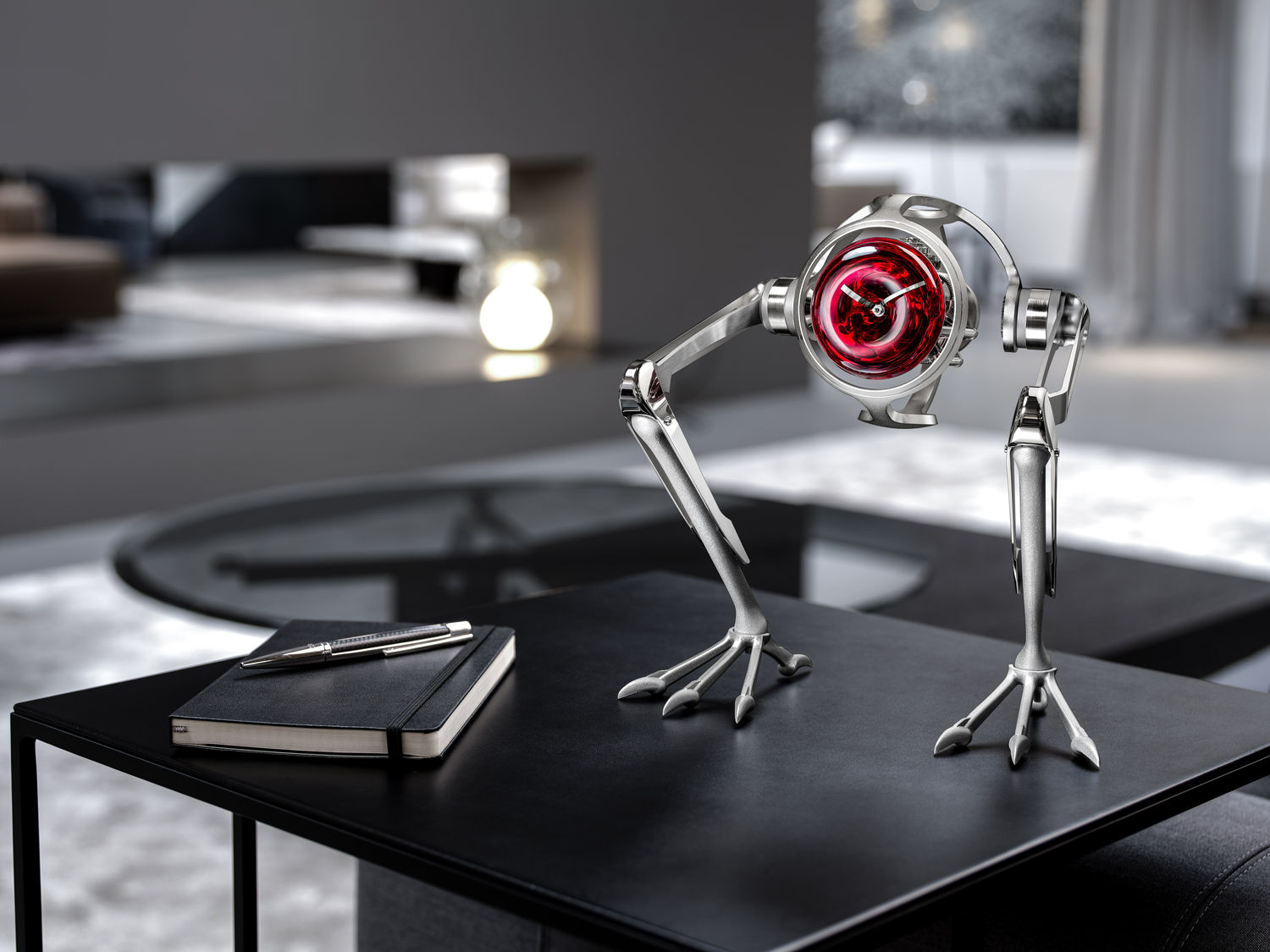
The Inspiration
Powerful and otherworldly, T-Rex was nevertheless drawn from a source both whimsical yet familiar. A quirky ornament on the desk of MB&F founder Maximilian Büsser, composed of a Christmas bauble perched atop two chicken legs. Members of the avian species are said to be modern-day descendents of the mighty dinosaurs of old, but the comic air of T-Rex’s inspiration had a long way to evolve before it came to fruition.
Designer Maximilian Maertens was the creative incubator for the eventual rise of T-Rex as the 11th collaboration between MB&F and L’Épée 1839. The 1993 film Jurassic Park was a big influence on Maertens, being the first movie he remembered watching as a child. Said Maertens, “I just had the idea to do something with dinosaurs, and Max (Büsser) was very interested in biomechanical designs at the time, so we melded these two sources around his little desk sculpture and took the next step.”
T-Rex is closely modelled on the actual skeleton of a Tyrannosaurus Rex, with Maertens studying 3D scans of dinosaur fossils to inject authenticity into the proportions and positioning of T-Rex’s legs.
In the course of designing T-Rex, Maertens even came up with a little backstory to inform the process of developing the perfect balance of mechanical and organic visual elements. “The story takes off from ideas given to me by past projects of MB&F, that we have a pilot in his starship discovering new planets. Eventually he got so far out in space that the only way back to Earth was via a black hole, but it time-warped him back to the time of dinosaurs and the starship was fused with a hatching dinosaur egg. You see the remnants of the starship in the body of the clock and the movement, the dinosaur appears via the legs, and even the black hole remains part of the design, via the dial that sinks inwards towards the centre where time originates.”
The Movement and Body
T-Rex is powered by a 138-component movement, designed and produced in house by L’Épée 1839, and finished to the very highest standards of traditional Swiss clockmaking. At the very top of the hand-wound movement, clearly visible through the skeletonised clock body surrounding it, is a balance beating at 2.5Hz (18,000vph). The eight-day power reserve is rewound directly via the barrel axis positioned at the back of the movement, while time is set through the centre of the dial. Both actions are taken with the same key.
Hand-blown Murano glass forms the clock dial of T-Rex, a material that both MB&F and L’Épée 1839 became thoroughly familiar with in the course of creating Medusa, their 10th collaboration. T-Rex comes in variations of green, deep blue and red Murano glass dials, which are vividly coloured with metallic salts via age-old techniques of glassblowing.
The 30-cm tall T-Rex is made of stainless steel and palladium-plated brass and bronze, weighing approximately 2kg distributed over two finely sculpted feet.
Tom & T-Rex: technical specifications
T-Rex comes in three limited editions of 100 pieces each, with Murano glass dials in green, deep blue or red.
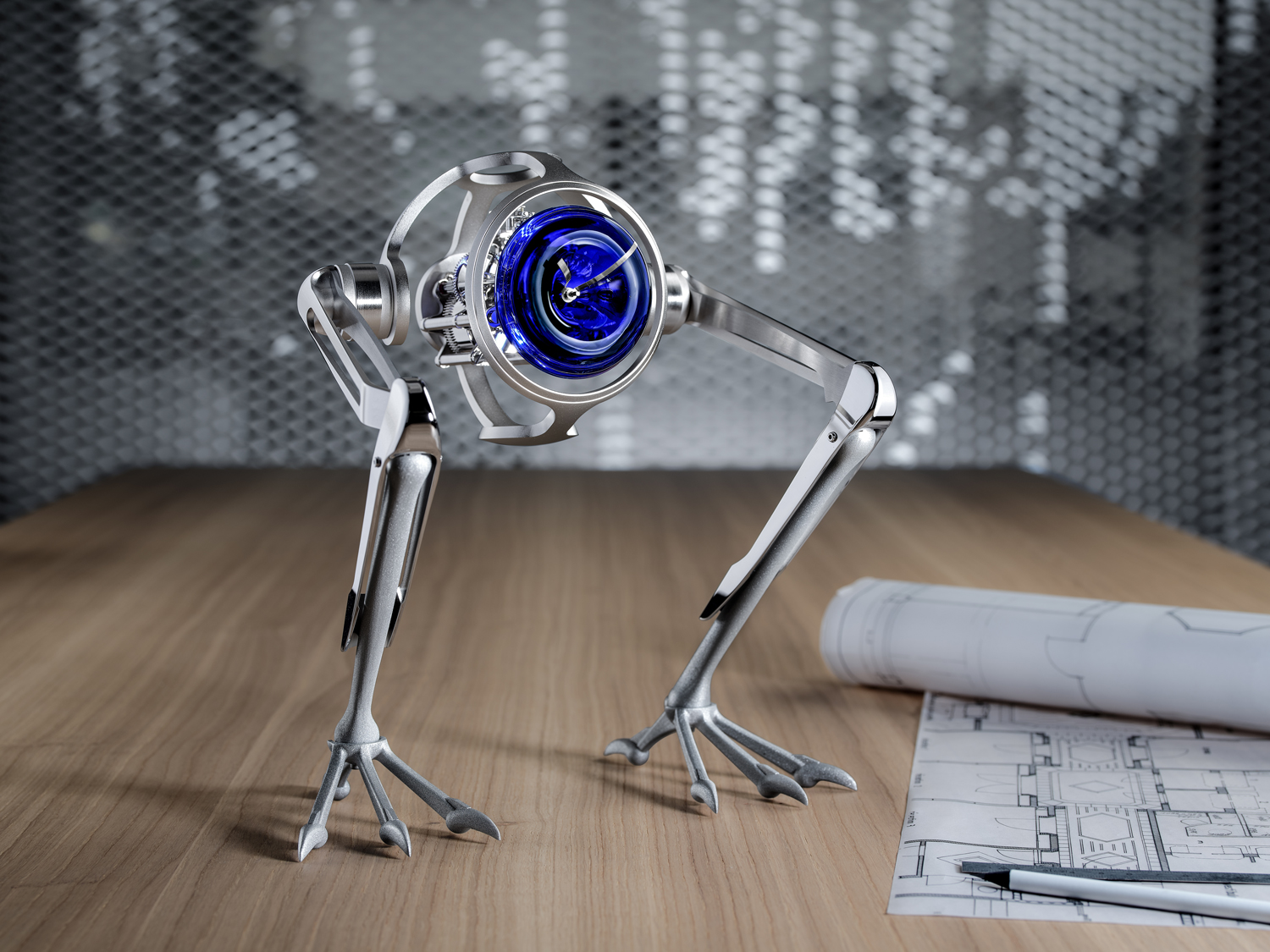
Display
Hours and minutes
Size
Dimensions: 265 mm tall x 258 mm x 178 mm
Total components (movement + body): 201
Weight: approximately 2kg
Body/frame
Dial: Murano hand-blown glass
Materials: stainless steel, palladium-plated brass and bronze
Finishing: polishing, satin-finishing and sandblasting
Body components: 63
Engine
L’Epée 1839 movement, designed and manufactured in-house
Balance frequency: 2.5 Hz / 18,000 vph
Power reserve: 8 days
Movement components: 138
Jewels: 17
Time setting: winding key to both set the time (in the centre of the dial) and wind the movement (on the barrel axis at the back)
L’EPEE 1839 – the premier clock manufacture in Switzerland
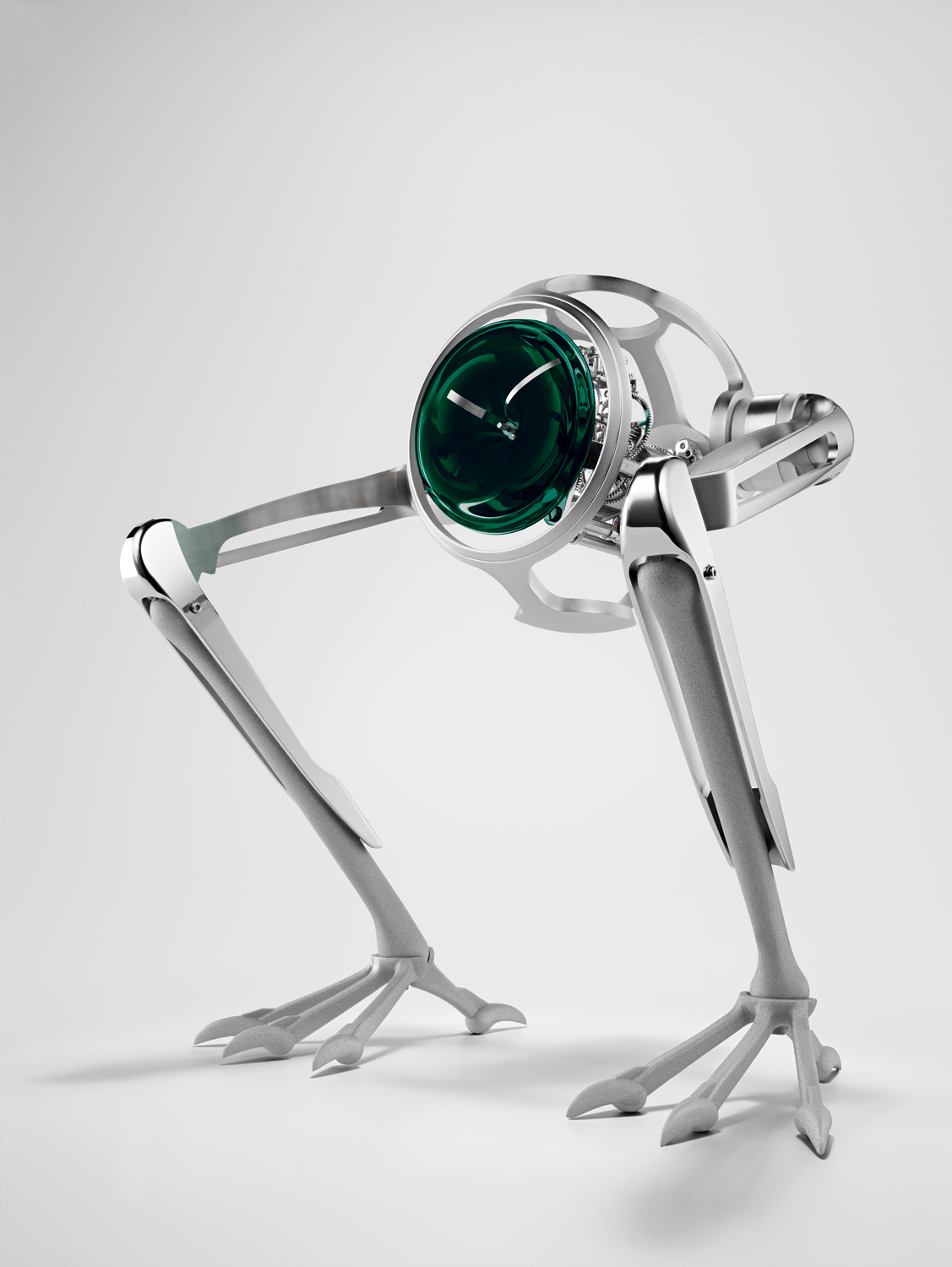
For more than 175 years, L’Epée has been at the forefront of clock making. Today, it is the unique specialised manufacture in Switzerland dedicated to making high-end clocks. L’Epée was founded in 1839, by Auguste L’Epée, who set up the business near Besançon, France to make music box and watch components.
From 1850 onward, the manufacture became a leading light in the production of ‘platform’ escapements, creating regulators especially for alarm clocks, table clocks and musical watches. By 1877, it was making 24,000 platform escapements annually. The manufacture became a well-known specialist owning a large number of patents on special escapements such as anti-knocking, auto-starting and constant-force escapements and the chief supplier of escapements to several celebrated watchmakers of the day. L’Epée has won a number of gold awards at international exhibitions.
During the twentieth century, L’Epée owed much of its reputation to its superlative carriage clocks and, for many, L’Epée was the clock of the influential and powerful; it was also the gift of choice by French government officials to elite guests. In 1976 when the Concorde supersonic aircraft entered commercial service, L’Epée wall clocks were chosen to furnish the cabins, providing passengers with visual feedback of the time. In 1994, L’Epée showed its thirst for a challenge when it built the world’s biggest clock with compensated pendulum, the Giant Regulator. At 2.2 m high, it weighs 1.2 tons – the mechanical movement alone weighs 120 kg – and required 2,800 man-hours of work.
L’Epée is now based in Delémont in the Swiss Jura Mountains. Under the guidance of CEO Arnaud Nicolas, L’Epée 1839 has developed an exceptional table clock collection, encompassing a range of sophisticated classic carriage clocks, contemporary design clocks and avant-garde horological sculptures. L’Epée clocks feature complications including retrograde seconds, power reserve indicators, perpetual calendars, tourbillons and striking mechanisms – all designed and manufactured in-house. Ultra-long power reserves have become a signature of the brand as well as superlative fine finishing.
MB&F – Genesis of a Concept Laboratory
2019 marked the 14th year of hyper-creativity for MB&F, the world’s first-ever horological concept laboratory. With 15 remarkable calibres forming the base of the critically acclaimed Horological and Legacy Machines, MB&F is continuing to follow Founder and Creative Director Maximilan Büsser’s vision of creating 3-D kinetic art by deconstructing traditional watchmaking.
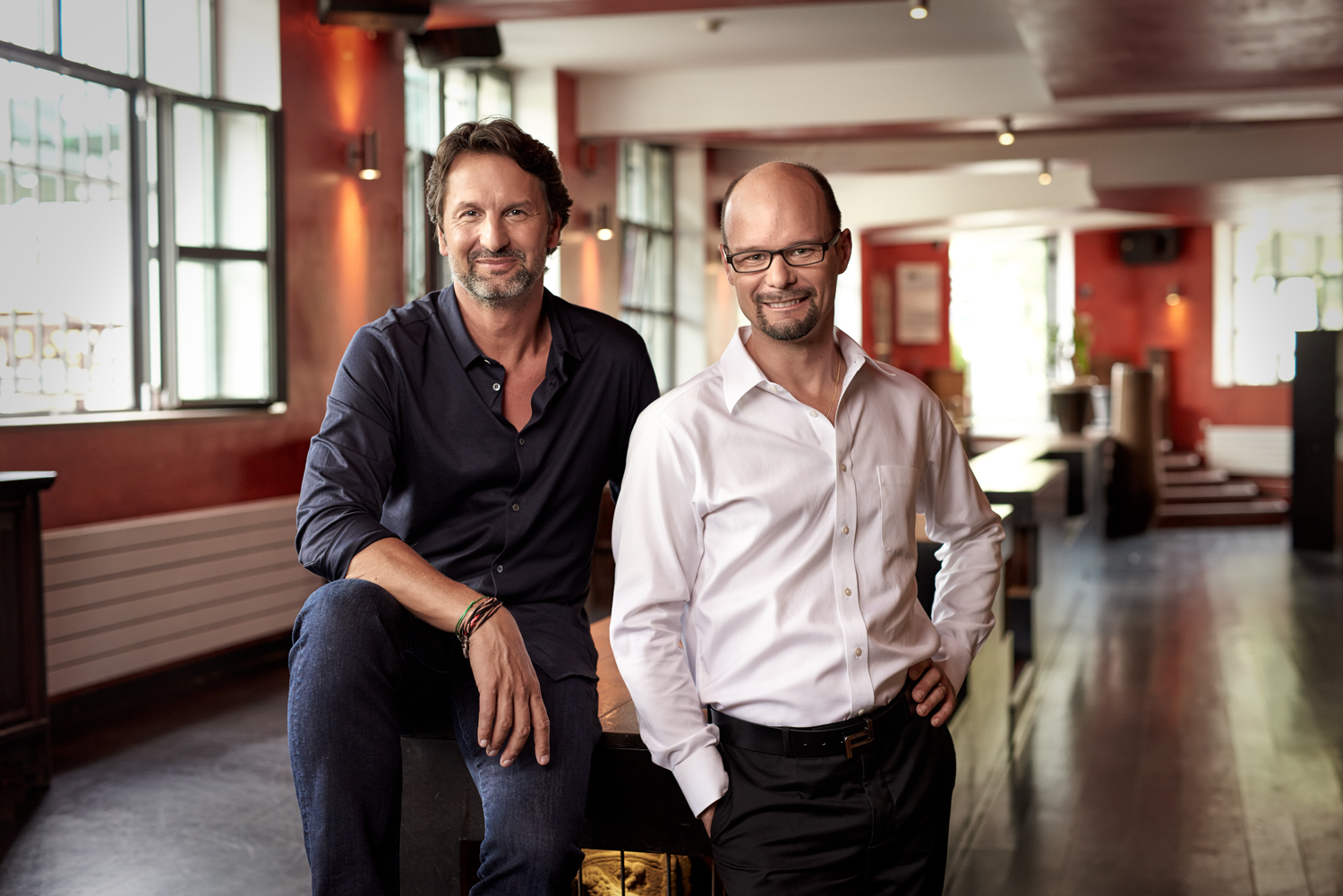
After 15 years managing prestigious watch brands, Maximilian Büsser resigned from his Managing Director position at Harry Winston in 2005 to create MB&F – Maximilian Büsser & Friends. MB&F is an artistic and micro-engineering laboratory dedicated to designing and crafting small series of radical concept watches by bringing together talented horological professionals that Büsser both respects and enjoys working with.
In 2007, MB&F unveiled its first Horological Machine, HM1. HM1’s sculptured, three-dimensional case and beautifully finished engine (movement) set the standard for the idiosyncratic Horological Machines that have followed – all Machines that tell the time, rather than Machines to tell the time. The Horological Machines have explored space (HM2, HM3, HM6), the sky (HM4, HM9), the road (HM5, HMX, HM8) and water (HM7).
In 2011, MB&F launched its round-cased Legacy Machine collection. These more classical pieces – classical for MB&F, that is – pay tribute to nineteenth-century watchmaking excellence by reinterpreting complications from the great horological innovators of yesteryear to create contemporary objets d’art. LM1 and LM2 were followed by LM101, the first MB&F Machine to feature a movement developed entirely in-house. LM Perpetual and LM Split Escapement broadened the collection further. 2019 marks a turning point with the creation of the first MB&F Machine dedicated to women: LM FlyingT. MB&F generally alternates between launching contemporary, resolutely unconventional Horological Machines and historically inspired Legacy Machines.
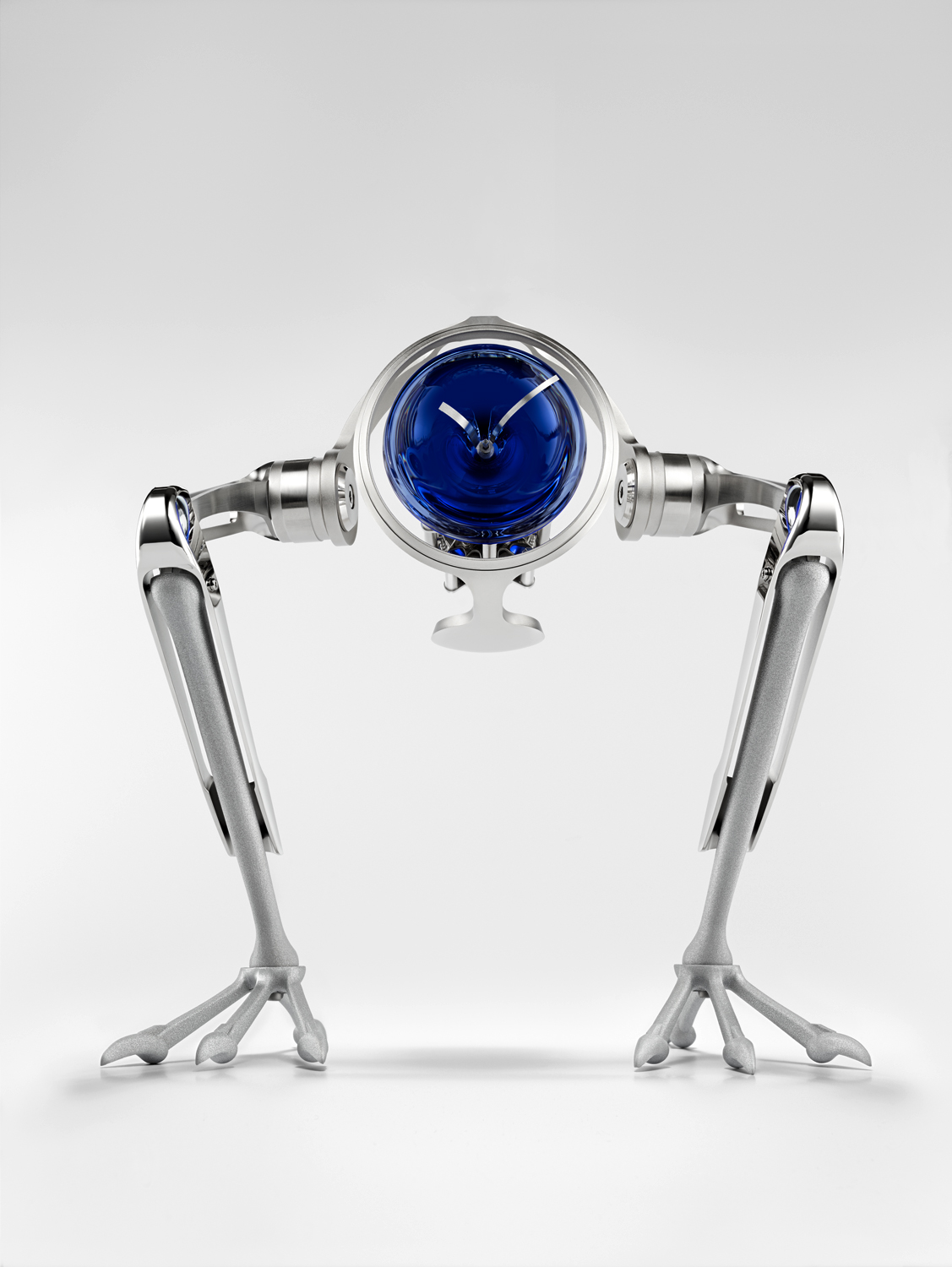
As the F stands for Friends, it was only natural for MB&F to develop collaborations with artists, watchmakers, designers and manufacturers they admire.
This brought about two new categories: Performance Art and Co-creations. While Performance Art pieces are MB&F machines revisited by external creative talent, Co-creations are not wristwatches but other types of machines, engineered and crafted by unique Swiss Manufactures from MB&F ideas and designs. Many of these Co-creations, such as the clocks created with L’Epée 1839, tell the time while collaborations with Reuge and Caran d’Ache generated other forms of mechanical art.
To give all these machines an appropriate platform, Büsser had the idea of placing them in an art gallery alongside various forms of mechanical art created by other artists, rather than in a traditional storefront. This brought about the creation of the first MB&F M.A.D.Gallery (M.A.D. stands for Mechanical Art Devices) in Geneva, which would later be followed by M.A.D.Galleries in Taipei, Dubai and Hong Kong.
There have been distinguished accolades reminding us of the innovative nature of MB&F’s journey so far. To name a few, there have been no less than 4 Grand Prix awards from the famous Grand Prix d’Horlogerie de Genève: in 2016, LM Perpetual won the Grand Prix for Best Calendar Watch; in 2012, Legacy Machine No.1 was awarded both the Public Prize (voted for by horology fans) and the Best Men’s Watch Prize (voted for by the professional jury). In 2010, MB&F won Best Concept and Design Watch for the HM4 Thunderbolt. In 2015 MB&F received a Red Dot: Best of the Best award – the top prize at the international Red Dot Awards – for the HM6 Space Pirate.

